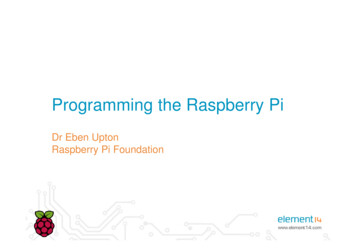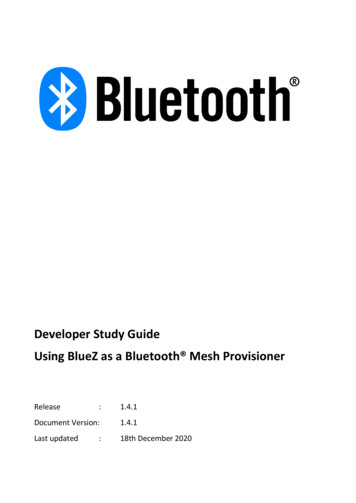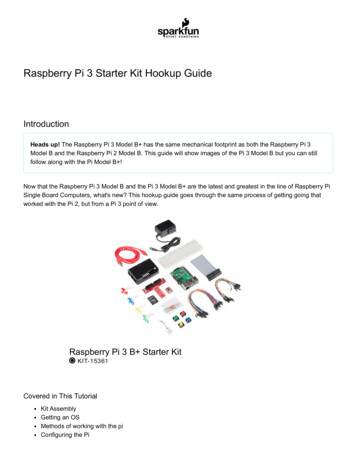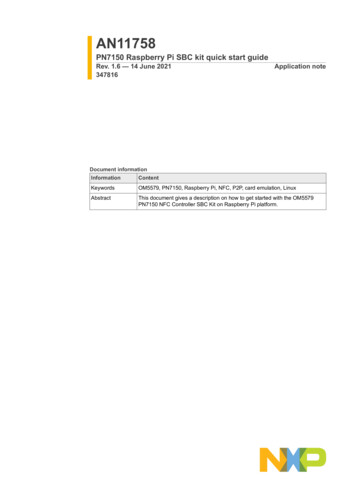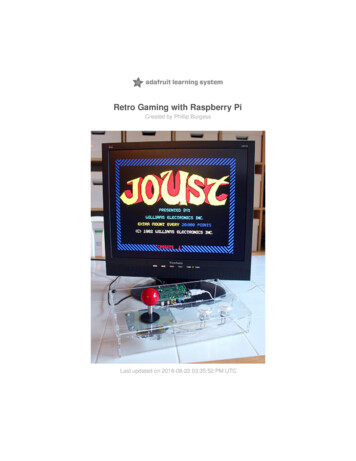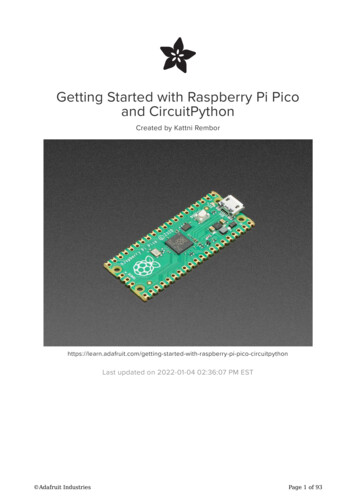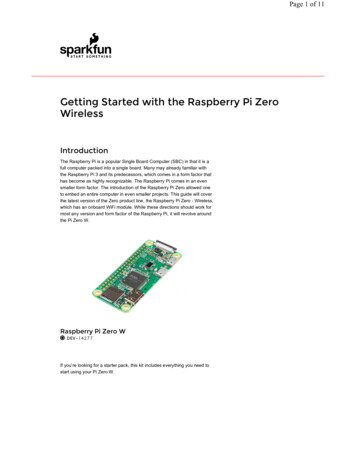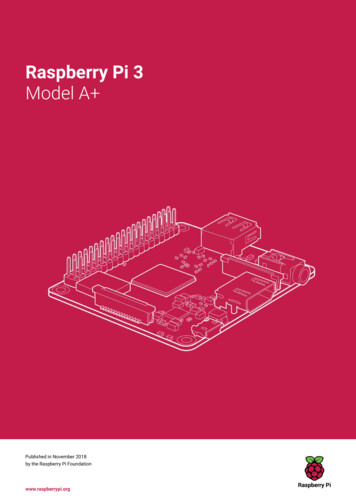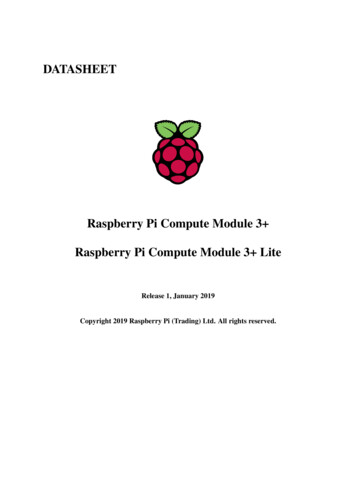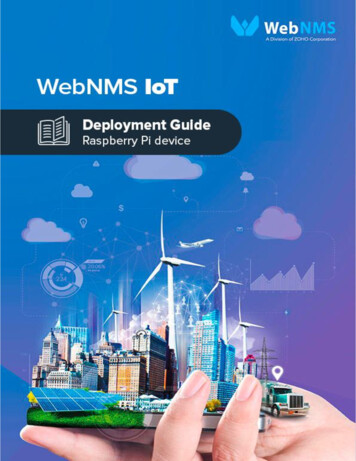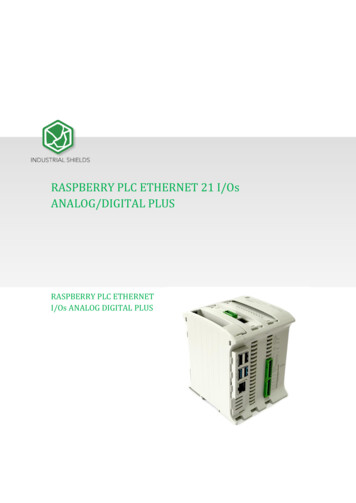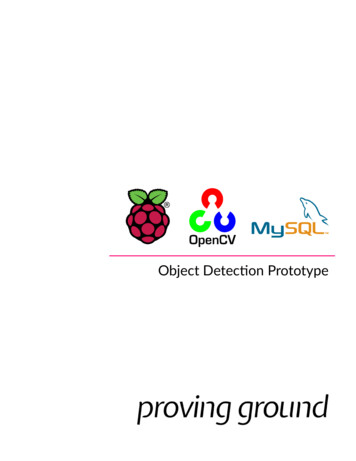
Transcription
Object Detection Prototype
Object Detection Introduction»»Computer vision (CV)is an interdisciplinary field that deals withhow computers can be made to gain high-level understandingfrom digital images or videos.»»Machine learning (ML) is the scientific study of algorithms andstatistical models that computer systems use to perform a specifictask without using explicit instructions, relying on patterns andinference instead.»»OpenCV (Open Source Computer Vision Library) is an open sourcemachine learning and computer vision library developed by Intelfor real-time image & video analysis and processing. Primarilywritten in C , This library has bindings for Python, Java, Matlab,Octave etc. Open-CV combined with python makes image/videoanalysis and processing astonishingly simple and for many, it canalso be the first step in the world of Computer Vision.»»In this document we look at how raspberry pi can be used formachine learning research using OpenCV and various objectdetection models and frameworks.»»We explored OpenCV using python and data collection setup withamazon web server and MySQL database to analyze the data andfurther visualize it on Power BI. (Refer to the diagram below)8/23/2019Page 1Human Count by Date-Time3.03.003.003.003.002.52.00Person 1.001.000.50.00.0012:17:00 PM12:18:00 PMDate Time12:19:00 PM0.0012:20:00 PM12:21:00 PM1/1Copyright 2019 Proving Ground LLC2
Raspberry Pi Introduction»»Raspberry Pi is the name of a series of single-board computers made by the Raspberry Pi Foundation, a UK charitythat aims to educate people in computing and create easier access to computing education.»»Raspberry Pi operates in the open source ecosystem: it runs Linux (a variety of distributions), and its mainsupported operating system, Raspbian, is open source and runs a suite of open source software. NOOBS is an easyoperating system installer which contains Raspbian. We are using Raspbian GNU/Linux 10 (buster) version 10.»»We have used Raspberry Pi 3 Model B (2018) and Arducam camera module for Raspberry Pi. Pi-camera can beconnected to the raspberry pi as an add-on accessory which will be used for object detection research.»»Copyright 2019 Proving Ground LLC3Since we are using Linux system on thePi, it is to be noted that the terminalor command-line is used to control thesystem. Command-line allows user todirectly manipulate their system throughthe use of commands.
OpenCV Installation»»The tutorial we followed to download OpenCV4 can be found here: penCV-4-on-your-raspberry-pi/Something to Keep in Mind:»»This will take up a significant amount of space on the Micro SD card of your Raspberry Pi.»»This demonstration can be done utilizing SSH which allows you to operate your Raspberry Pi, but we will do thiswith physical access to the Raspberry Pi terminal.»»Follow the instructions on the tutorial. Once you have installed all the supportive libraries and pip, you will createyour virtual environment. It is important to get this step right because you will create the OpenCV in the virtualenvironment. Once downloaded, OpenCV will only be accessible in this virtual environment.»»Virtual environment is a python component that creates an isolated environment for python projects. This meansthat each project can have its own dependencies, regardless of what dependencies every other project have. Virtualenvironment by the name ‘cv’ is created to download OpenCV in this document.»»It can be challenging to download OpenCV or Tensorflow on raspberry pi since it’s important to have the rightversions installed and also using the command line can be foreign concept.»»After this step: sudo pip install virtualenv virtualenvwrapper sudo rm -rf /get-pip.py /.cache/pip»»Open: nano /.profile»»Once in the profile, copy and paste the command for the virtual environment and virtual environment wrapper tothe end of the command explanation: »»# virtualenv and virtualenvwrapperexport WORKON HOME HOME/.virtualenvsexport VIRTUALENVWRAPPER PYTHON /usr/bin/python3source /usr/local/bin/virtualenvwrapper.shThe next step will access your virtual environment so that you can build the OpenCV in it. source /.profile»»Continue through the tutorial until you reach: make -j4»»Reserve a few hours for this step. This is when OpenCV will install onto your Raspberry Pi.»»Continue on to finish the tutorial and feel free to follow along with the practice example given.Copyright 2019 Proving Ground LLC4
1. Simple Object Detection»»In this example we see how human face can be detected and from a live video feed to record the presence ofnumber of humans present in the frame and detect their movement. It is further used to record number of facedetected in the room at a given time which is stored in Amazon web server and visualize it on Power BI throughMySQL workbench.»»We have followed the blog post by Pyimagesearch on Simple object detection and customized the data beingcollected. You can find the link to the bold post here- jecttracking-with-OpenCV/»»Object Tracking process:»» Initial Object detection using CNN object detector Create unique ID for each detection Track the IDs through centroid tracker Upload the data collection to MySQL Visualize data collected on Power BIStep 1 : Activate the Virtual Environment (cv) and navigate to the folder location using command line. Further deploythe python file along with its caffe model (Caffe model is a deep learning framework). Since this example usesargument parser, caffe model and prototxt files can be replaced with the latest suitable library available on OpenCVonline. source /.profileworkon cvcd /simple-object-tracking # folder name found inside user folder pipython object tracker.py --prototxt deploy.prototxt --model res10 300x300 ssd iter 140000.caffemodel»»Important snippets from the python file and further customization of the code to collect data is noted below.»»MySQLdb is imported along with datetime to record the time to the database. MySQLdb has to be downloadedon virtual environment (cv). Downloading mysql-client, mysql-connector, mysql-connector-python on the virtualenvironment cv helped us to successfully import MySQLdb statement and execute the python script.Copyright 2019 Proving Ground LLC5
»»Data being recorded are the rectangle drawn from the frame after object detection is done.»»Cameraid is a constant value that records the pi-camera and its respective Raspberry Pi being used. In this examplewe are extracted values from a single Pi.»»Line 88-90 is collecting date and time.»»Below snippet shows the connection to database and the data formated according to the table that is created This is printing the values that is being uploaded to the database on the terminal at an regular time interval of 2seconds. Data recorded is also being uploaded every two second»»This example fall short in few ways. Although it is detecting human face, the centroid tracker is not accurate withrespect to object movement. Also proximity of background subtraction done is not precise to locate farther objectswith pi-camera.Copyright 2019 Proving Ground LLC6
2. Filter Object Detection»»In this example we see how person can be detected and from a live video feed to record the presence of numberof humans present in the frame and detect their movement. It is further used to record number of people detectedin the room at a given time which is stored in Amazon web server and visualize it on Power BI through MySQLworkbench.»»We have followed the blog post by Pyimagesearch on Filter object detection and customized the data beingcollected. You can find the link to the bold post here- guideto-deep-learning-object-detection/»»Object Tracking process: Initial object detection using COCO base model Filter person from other common objects Upload the data collection to MySQL Visualize data collected on Power BI»»Step 1 : Activate the Virtual Environment (cv) and navigate to the folder location using command line. Further deploythe python file along with its caffe model (Caffe model is a deep learning framework). Since this example usesargument parser, caffe model and prototxt files can be replaced with the latest suitable library available on OpenCVonline.»»Important snippets from the python file and further customization of the code to collect data is noted below. source /.profile workon cv cd /filter-object-detection # folder name found inside user folder pi python filter object detection.py --prototxt MobileNetSSD deploy.prototxt.txt --model MobileNetSSD deploy.caffemodel»»MySQLdb is imported along with datetime to record the time to the database. MySQLdb has to be downloadedon virtual environment (cv). Downloading mysql-client, mysql-connector, mysql-connector-python on the virtualenvironment cv helped us to successfully import MySQLdb statement and execute the python script.Copyright 2019 Proving Ground LLC7
»»COCO (common object in context) model is a collection of 20 common objects to detect. Objects can be filteredby setting the ignore class. In this example since we are looking for person detection, we are going to ignore everyother object except “person”.»»Object detection is counted for data collection and since we are have ignore all the other objects we are justcounting humans.»»Cameraid (line 78) is a constant value that records the pi-camera and its respective Raspberry Pi being used. In thisexample we are extracted values from a single Pi.»»Line 80-82 is collecting date and time.»»Below snippet shows the connection to database and the data formated according to the table that is created This is printing the values that is being uploaded to the database on the terminal at an regular time interval of half asecond. Data recorded can be set at 2 seconds which is good enough to analyze for machine learning.»»Note that time.sleep line is used at other places to start the object detection and end the detection. It is importantto set this statement associated with mySQLdb data collection as well.»»To stop the python file from running the object tracking click on the video frame and ‘q’ on the keyboard as it is setas the break key in the code.Copyright 2019 Proving Ground LLC8
»»This example also reads the elapsed time of the data recorded as well as approximate FPS at which the file wasexecuted.»»It is to be noted that since we are using Raspberry pi for computer vision, the FPS of the executed file is extremelyslow. Maximum FPS we attained is 0.5 while using other system the same example can be executed at about 20FPS.»»People recognition is pretty good in this example since we are using COCO model which is widely used modelas well as the confidence is set at 0.2 which ranges from 0 to 1. Confidence is the minimum probability of thedetection set to filter out weak detection.Copyright 2019 Proving Ground LLC9
MySQL Database:»»For the next step of this, we will be working in MySQLWorkbench to read the data collected from the object detectionusing OpenCV and Python from Raspberry Pi.»»You will have to have your own MySQL Server and password atwhich point you can open and load MySQL Workbench.»»Running this script through MySQL gives us a table named“HumanIdData”. This gives a destination for the information ofthe python script.»»In this table we are recording cameraID, date, time and humanIDor human count.»»Copyright 2019 Proving Ground LLC10Opening the tab you have labeled, in thiscase “HumanIdData” you should see yourvalues start to load into the table with atime stamp on each value. We used twodifferent python scripts that each definedwhich CameraID was which. Multiplecameras associated to its system can beused to analyze various rooms or locationto collect data.
Power BI:»»To take your data a step further, we can load your collected datainto Power BI to visually explain your data.»»Select “Get Data,” from which you can pick MySQL database toextract your data from. You will need to log in to your serveragain.»»Your data should appear in the “Fields” section of Power BItowards the left. You can alter how you view your information in“Visualizations” next to “Fields.”»»The visualized data shown below is within a small time frame tounderstand clearly the movement in the room in which the Picamera is set up.8/23/2019Page 1Human Count by Date-Time65Person .01.01.00.012:17:00 PM12:18:00 PMDate Time12:19:00 PM0.012:20:00 PM12:21:00 PM1/1Copyright 2019 Proving Ground LLC11
Copri 2 roin round C 3 » Raspberry Pi is the name of a series of single-board computers made by the Raspberry Pi Foundation, a UK charity that aims to educate people in computing and create easier access to computing education. » Raspberry Pi operates in the open source ecosystem:
